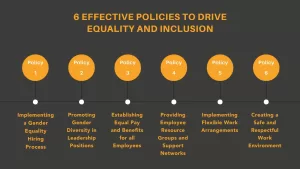
Introduction
In today’s corporate landscape, gender diversity has become a crucial topic of discussion. While progress has been made to advance the rights and opportunities for women in the workplace, there is still a significant gap to bridge. Gender diversity is not just a buzzword, but a necessary element for driving innovation, creativity, and overall business success. It is essential for companies to implement effective policies and strategies that promote equality and inclusion. This article will explore six impactful policies that can help boost gender diversity at the workplace, creating a more equitable and empowering environment for all employees.
The Importance of Gender Diversity in the Workplace
Gender diversity in the workplace is not just a matter of social justice; it is also essential for business success. A diverse workforce brings together individuals with different perspectives, experiences, and skills, resulting in increased creativity, innovation, and problem-solving capabilities. A gender-diverse team can offer a broader range of ideas and insights that can drive the development of new products and services, enhance customer satisfaction, and increase profitability.
Moreover, gender diversity fosters a more inclusive and welcoming work environment. When employees see that their company values and promotes diversity, they are more likely to feel valued and supported, resulting in increased employee engagement, satisfaction, and retention. A diverse workforce also enhances a company’s reputation, making it more attractive to diverse talent.
By prioritizing gender diversity and implementing effective policies, companies can reap these benefits and position themselves as leaders in creating a more equitable and inclusive workplace.
Policy 1: Implementing a Gender Equality Hiring Process
The first policy that organizations can adopt to boost gender diversity is implementing a gender equality hiring process. This involves actively working towards reducing any unconscious bias that may exist during the recruitment and selection process. It is essential to ensure that all candidates are given an equal opportunity to compete for positions, regardless of their gender.
One effective way to achieve this is by anonymizing resumes during initial screening to remove any personal identifiers such as name, gender, and age. This approach allows hiring managers to focus solely on the qualifications and skills of the candidates. Additionally, organizations can provide unconscious bias training to hiring managers and interview panels to raise awareness of potential biases and help them make objective decisions.
By implementing a gender equality hiring process, companies can attract a more diverse pool of candidates, allowing them to tap into a wider range of talent and perspectives. It also sends a strong message that the company values equal opportunities for all and is committed to creating a level playing field.

Policy 2: Promoting Gender Diversity in Leadership Positions
Another effective policy that organizations can adopt to boost gender diversity is promoting gender diversity in leadership positions. This means actively working towards achieving a more balanced representation of women in senior management and executive roles.
One way to achieve this is by implementing mentorship and sponsorship programs specifically designed to support and advance women in their careers. These programs can provide guidance, support, and opportunities for skill development, helping women break through barriers and reach higher levels of leadership within the organization.
Additionally, companies can establish clear diversity and inclusion goals that focus on increasing the percentage of women in leadership positions. This can be done by tracking and regularly reporting on gender representation at different levels of the organization, and implementing initiatives to address any imbalances or barriers that may exist.
Promoting gender diversity in leadership positions not only brings a fresh perspective and diversity of thought to decision-making processes but also serves as inspiration and motivation for other women within the organization to aspire to leadership roles. It sends a powerful message that women have the same opportunities for growth and advancement as their male counterparts, contributing to a more inclusive and equitable workplace culture.
Policy 3: Establishing Equal Pay and Benefits for all Employees
Another crucial policy to drive gender diversity and equality in the workplace is establishing equal pay and benefits for all employees. Despite progress made in many industries, gender pay gaps still persist, with women earning less than men for performing the same job.
Organizations should conduct regular pay audits to identify and address any disparities in compensation based on gender. This includes scrutinizing all elements of pay, such as base salary, bonuses, and allowances, ensuring that there are no discrepancies between male and female employees.
Furthermore, companies must ensure that benefits, such as health insurance, maternity and paternity leave, and retirement plans, are offered equally to all employees, regardless of their gender. By providing equal benefits, organizations demonstrate their commitment to fairness and inclusivity, while also providing support to employees as they navigate various life stages.
Establishing equal pay and benefits not only helps to bridge the gender wage gap but also fosters a culture of equality, where every employee feels valued and appreciated for their contributions. This policy sends a clear message that the organization values the work of all its employees, regardless of their gender, promoting a more diverse and inclusive work environment.
Policy 4: Providing Employee Resource Groups and Support Networks
In addition to establishing equal pay and benefits, another effective policy to drive gender diversity and inclusion in the workplace is providing employee resource groups and support networks. These groups create a platform for employees to connect, support and empower each other based on shared experiences and identities.
Employee resource groups can vary in focus, from women in leadership to working parents or LGBTQ+ individuals. By providing spaces where employees can openly discuss their challenges and successes, organizations foster a sense of belonging and create opportunities for personal and professional growth.
Support networks can offer mentorship programs, networking events, and workshops tailored to address the unique needs of these groups. This helps to break down barriers and provides a support system for employees to excel in their careers.
Research has shown that companies with robust employee resource groups and support networks experience higher employee satisfaction, retention, and productivity. These initiatives demonstrate a commitment to diversity and inclusion by actively promoting an inclusive culture where all employees are valued and can thrive.
Implementing employee resource groups and support networks can serve as powerful tools to attract and retain top talent, foster innovation, and create a workplace culture that celebrates and embraces everyone’s unique experiences and contributions. Organizations that prioritize these initiatives not only benefit their employees but also gain a competitive edge in today’s diverse and globalized marketplace.
Policy 5: Implementing Flexible Work Arrangements
Another effective policy to boost gender diversity and inclusion at the workplace is the implementation of flexible work arrangements. As our world becomes more interconnected and technology-driven, traditional 9-to-5 office hours are becoming less relevant. Providing flexible work options allows employees to better manage their personal and professional responsibilities, which is particularly important for working parents and caregivers.
Flexible work arrangements can take different forms, such as remote work, flexible start and end times, compressed work weeks, and job sharing. These options not only provide employees with a better work-life balance but also create an inclusive environment that values diverse needs and circumstances.
Additionally, flexible work arrangements have been shown to increase job satisfaction, motivation, and productivity. When employees have the autonomy and flexibility to choose how and when they work, they have more control over their schedules and can better meet both individual and organizational goals.
By implementing flexible work arrangements, organizations demonstrate their commitment to supporting employees’ personal well-being and career advancement. This policy helps attract and retain diverse talent, as it recognizes that individuals have different needs and responsibilities outside of work, ultimately contributing to a more inclusive and successful workplace culture.
Policy 6: Creating a Safe and Respectful Work Environment
Creating a safe and respectful work environment is crucial for promoting gender diversity and inclusion at the workplace. In order for employees to thrive and contribute their best, it is essential that they feel safe, respected, and valued.
Organizations can implement policies to ensure that all employees are treated with fairness and dignity. This includes establishing zero tolerance for harassment, discrimination, and bullying in any form. Clear guidelines and procedures should be put in place for reporting incidents and addressing them promptly and confidentially.
Training programs can educate employees on identifying and preventing behaviors that violate the organization’s policies. These programs should also include a focus on unconscious biases and promote cultural sensitivity and empathy.
By creating a safe and respectful work environment, organizations foster a sense of belonging and psychological safety for all employees. This policy not only encourages diverse individuals to join the organization, but also enables them to contribute their unique perspectives and talents without fear of judgment or mistreatment.
Conclusion: Making Gender Diversity a Priority
Achieving gender diversity and equality in the workplace goes beyond creating a safe and respectful environment. It also involves addressing the issue of gender pay disparity. Conducting regular gender pay gap analyses is a crucial step in identifying and rectifying any discrepancies in compensation.
By analyzing the data, organizations can identify areas where gender pay gaps exist and take corrective action to ensure fair and equal pay for all employees. This can include implementing transparent salary structures, reviewing and adjusting compensation policies, and providing opportunities for career advancement and development for women.
Regular reviews and updates to address any pay gaps are essential to cultivating a work environment that values and rewards all employees equally, regardless of their gender. By addressing the issue of gender pay disparity, organizations can further demonstrate their commitment to gender diversity and inclusion.
SILA adopts a tech-driven approach, utilizing Robotics and IoT, Automated Compliance Management, and our proprietary technology (SILA Connect) to efficiently manage properties across India. As pioneers in technology within the facility management sector, SILA stands out as one of the best facility management service provider in India.
To delve deeper into our integrated facility management services, click here.
Industries We serve –
Commercial Offices & Buildings | Manufacturing & Heavy Industrial Facilities | Residential Complexes & Townships | Hotels & Campuses | Airports & Malls | IT Parks & Data Centers | Warehousing & Logistics Parks | Banks & Retail
Present in 125 cities –
Ahmedabad | Baroda | Bengaluru | Chennai | Bhubaneswar | Delhi | Gurugram | Noida | Kolkata | Hyderabad | Kochi | Mumbai | Pune & more
Get a free quote today, to reduce your facility management cost.
1. What are the key challenges faced in Facility Management?
Challenges may include maintaining ageing infrastructure, ensuring compliance with industry regulations, optimizing energy usage, managing risks associated with hazardous materials, and adapting to technological advancements.
2. What strategies are used to ensure safety in facilities?
Safety protocols, regular safety training for occupants of the space, implementation of proper equipment maintenance schedules, conducting risk assessments, and compliance with safety regulations are some strategies employed to maintain a safe working or living environment.
3. How does Facility Management contribute to sustainability?
FM practices focus on reducing waste generation, optimizing energy consumption, adopting eco-friendly technologies, and implementing recycling programs, thereby contributing to environmental sustainability.
4. What are the benefits of outsourcing Facility Management services?
Outsourcing FM services can provide specialized expertise, cost-effectiveness, access to advanced technology, scalability, and the ability to focus on core business activities while experts manage facility operations.
About SILA -
A Real Estate platform driven by an entrepreneurial spirit.
Our businesses include Real Estate Services which offer Facility Management, Contracting Solutions and Real Estate Advisory. Our other business is Real Estate Development. We have a diverse client base in various sectors which include large Corporates, Real Estate Funds, Landowners and Developers.
Over the last decade, SILA has scaled efficiently, managing over 150 million square feet of assets, with over 20,000 employees pan India. The platform is backed by Norwest Venture Partners and Samara Capital Group in our Real Estate Services and Development arms, respectively.
SILA is one of the best facility management service provider in Mumbai, Bengaluru, Delhi, Chennai, Hyderabad, Pune & more.
SILA is among the top facility management companies in India, offering comprehensive property management services and housekeeping solutions. As a leading facilities management company, SILA provides tailored FM solutions, including housekeeping services in Mumbai. Leveraging our expertise, we ensure seamless property management for clients nationwide. Whether you require housekeeping agency support or specialized facility management solutions, SILA delivers excellence in every aspect of your property’s upkeep and maintenance.
About Author -

Aniket Sheth
The insightful content in this blog is curated by Aniket Sheth, our esteemed Senior Vice President of Operations. With an impressive professional journey spanning over 13 years, Aniket has held key positions at prestigious brands, showcasing his exceptional leadership skills.
Aniket’s educational background is marked by an MBA from Cornell University, which laid the foundation for his successful career. He began his professional journey at EY in New York, contributing significantly to enhancing and implementing engagements for Fortune 500 companies.
Aniket’s strategic acumen, proficiency in asset management, and forward-thinking innovation have been instrumental in helping companies streamline their operations and achieve substantial cost reductions. His wealth of experience brings a unique perspective to the world of facilities management, making his insights invaluable for businesses seeking operational excellence.
References:
– Xie Y., Zhang J., Zhang R., & Li Y. (2021). Work-Life Balance Policies: A Review and Research Agenda. Frontiers in Psychology, 12, 665607.
– Gajendran, R. S., & Harrison, D. A. (2007). The good, the bad, and the unknown about telecommuting: Meta-analysis of psychological mediators and individual consequences. Journal of Applied Psychology, 92(6), 1524-1541.
– Fitzgerald, L. F., Drasgow, F., Hulin, C. L., Gelfand, M. J., & Magley, V. J. (1997). Antecedents and consequences of sexual harassment in organizations: A test of an integrated model. Journal of Applied Psychology, 82(4), 578-589.
– Morrison, E. W., & Robinson, S. L. (1997). When employees feel betrayed: A model of how psychological contract violation develops. Academy of Management Review, 22(1), 226-256.
– Blau, F. D., & Kahn, L. M. (2017). The gender wage gap: Extent, trends, and explanations. Journal of Economic Literature, 55(3), 789-865.
– Cook, A., & Glass, C. (2014). Women and top leadership positions: Towards an institutional analysis. Gender and Society, 28(3), 411-433.





















